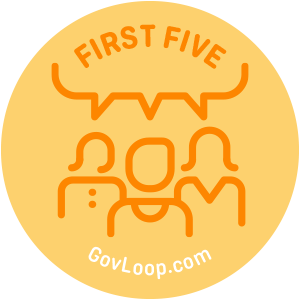 This blog is an excerpt from our popular research guide, “Getting into Government: A Guide for High Achievers.” To download the full guide, click here.
This blog is an excerpt from our popular research guide, “Getting into Government: A Guide for High Achievers.” To download the full guide, click here.
Choosing on a career in public service is a serious decision but an exciting one. As a result, you work hard in school, in your extracurriculars and at your job. You never pass up an opportunity to meet new people and learn more. You have big goals and aspirations and wouldn’t dream of settling for less. You’re a high achiever and you’re hoping to get into government to land the perfect job.
For all you over-achieving high achievers out there, we have the perfect guide for you. GovLoop partnered with the Robertson Foundation for Government to provide young professionals looking to enter government with resources, tips and a few tricks to navigate the maze of public service jobs.
While I strongly recommend you download and read the whole guide, here are a few highlights that can help you navigate your public service career:
Discover
You may be wondering: “How do I find those government career opportunities? The first thing you want to do, especially if you want to work in federal government, is set up your USAJobs account.
Then decide on the community in which you want to serve. If you’re looking to make a global impact, look at international jobs. Or maybe you want to serve in the intelligence community. See IntelligenceCareers.gov to check out a group of 17 federal intelligence agencies working to protect the US. If you’re not quite sure which community you want to be in, but definitely know you want to be a public servant, special hiring programs may be the right path for you. There are a number of options such as Pathways Programs, Presidential Management Fellowships and a recent graduates or student trainees programs.
Decipher
But searching and discovering are just the first hurdles to getting a government job. Understanding the government hiring process is critical to helping you advance in your public service career. Because once you find a position that interests you, it’s always a bit challenging to understand the actual job descriptions.
Are you great at cost-benefit analysis or accounting? Narrow your job search by categories, like “budget analysis.” Maybe you’re a strong program manager and researcher: search for titles like “Program Analyst.”
Then, identify what fits you best in terms of occupational series number. For example, if you’re a lawyer, see Series 0900. Budget accountant, check out Series 0500. The Office of Personnel and Management has a 200-handbook of occupational series and families to browse. Once you’ve narrowed down by job categories and titles, you’ll want to further refine your search by salary or pay grade. For grade series, this is the general breakdown.
- GS-5 = Entry-level, straight out of college
- GS-7 = Undergraduate with a grade point average of 3.0 or above or with a bachelor’s degree and one year of relevant experience
- GS-9 = People with master’s degree OR with a bachelor’s plus one year of relevant experience equivalent to a GS-7
- GS-11 = Mid-career people who are ready to take the next step; they have their master’s or bachelor’s and five years of experience; also for people with PhD.
Applying for government jobs isn’t about shooting out 100 or more resumes and hoping someone will take the bait. It’s a time consuming process and deciphering which jobs are right for you requires careful thought, time and consideration. In the end, you’ll save yourself a lot more time and will be more likely to successfully land a job.
Deliver
Cut through a field of crowded candidates to ensure you actually drive home the point that you’re qualified and ready to rock a government job. But how exactly do you do that? One place to start is nailing that government resume.
While it seems like the USAJobs resume builder is helpful in that it ensures you have all the necessary information, like clearance levels and previous salaries, which may not be in your personal resume.
At the same time, USAJobs allows you to save up to 10 resume templates – and you’ll want to create a different, tailored resume for each job to which you apply. If you do decide to create your resume outside of USAJobs, or if you’re looking to apply to a non-federal government job, keep the following tips in mind:
- Master the formatting basics. Don’t worry about length, as public sector resumes are normally five to seven pages long. At the same time, don’t waste valuable space with fancy titles or fonts.
- Keep your audience in mind. Speak the language of the prospective employer. Even if most of your experience is based in the private sector or in academia, use descriptors similar to the position you’re applying for and highlight how your experiences are relevant to that position.
- Structure your experience. Consider using “modified chronological format.” This is a hybrid version of functional and chronological formats but has subsections focused on the skill set the employers seek. Quantify your experiences as well. For example, if you were an events coordinator, tell them exactly how many events you planned and executed.
Discover, decipher and deliver your way into your high-achieving government career. It can be a tedious, time-consuming process, but putting in the effort now will more than likely pay off in the end. Hopefully, these tips can help you land your dream public service job.
This article was originally posted in January, 2016.
This post is part of GovLoop’s millennial blog series, First 5





Leave a Reply
You must be logged in to post a comment.